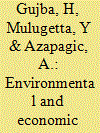| Srl | Item |
| 1 |
ID:
098601


|
|
|
|
|
| Publication |
2010.
|
| Summary/Abstract |
The power sector in Nigeria is undergoing structural reforms aimed at improving and expanding the current grid generation capacity and distribution network. The Government has injected huge funds into this sector while also granting licences to private companies for the provision of electricity. It is also aiming to increase electricity generation capacity to 25,000 MW by 2020 from the current installed capacity of 6500 MW while also pledging to connect 75% of the population to the grid from the current 40% by 2025. This paper sets out to analyse the implications of the energy policy in Nigeria and presents the life cycle environmental and economic analysis of the current and future electricity sector. The results show that all the life cycle impacts and economic costs increase significantly over the time-period (2003-2030), but at different rates depending on the types of technologies deployed. Renewables such as large hydro and solar proposed by the Government have a potential to reduce the overall life cycle environmental impacts from the electricity mix, considering their lower environmental impacts compared to fossil-fuels. However, this requires a five-fold increase in grid investments from the current US$1.7 billion per year to US$9.40 billion by 2030.
|
|
|
|
|
|
|
|
|
|
|
|
|
|
|
|
| 2 |
ID:
119809


|
|
|
|
|
| Publication |
2013.
|
| Summary/Abstract |
This paper presents the life cycle environmental impacts and economic costs of the passenger transport sector in Nigeria for 2003-2030. Four scenarios are considered: business as usual (BAU); increased use of public transport (buses) at the expense of cars (LOWCAR) and motorcycles (LOWMC), respectively; and high economic growth with increased car ownership and decline of public transport (HICAR). The findings show that for the BAU scenario the life cycle environmental impacts double over the period, despite the assumption of increased fuel and vehicle efficiency of 35% over time. The total fuel costs at the sectoral level increase three times, from US$3.4 billion/yr in 2003 to US$9.7 billion in 2030. Increasing the use of buses would reduce the environmental impacts on average by 15-20% compared to BAU; at the same time, the total fuel costs would be 25-30% lower. If the use of cars grows much faster due to a high economic growth as in HICAR, the environmental impacts and fuel costs would increase by 16% and 26%, respectively. These results demonstrate clearly that future transport policy in Nigeria should promote and incentivise public (bus) transport as a much more environmentally and economically sustainable option than transport by cars and motorcycles.
|
|
|
|
|
|
|
|
|
|
|
|
|
|
|
|